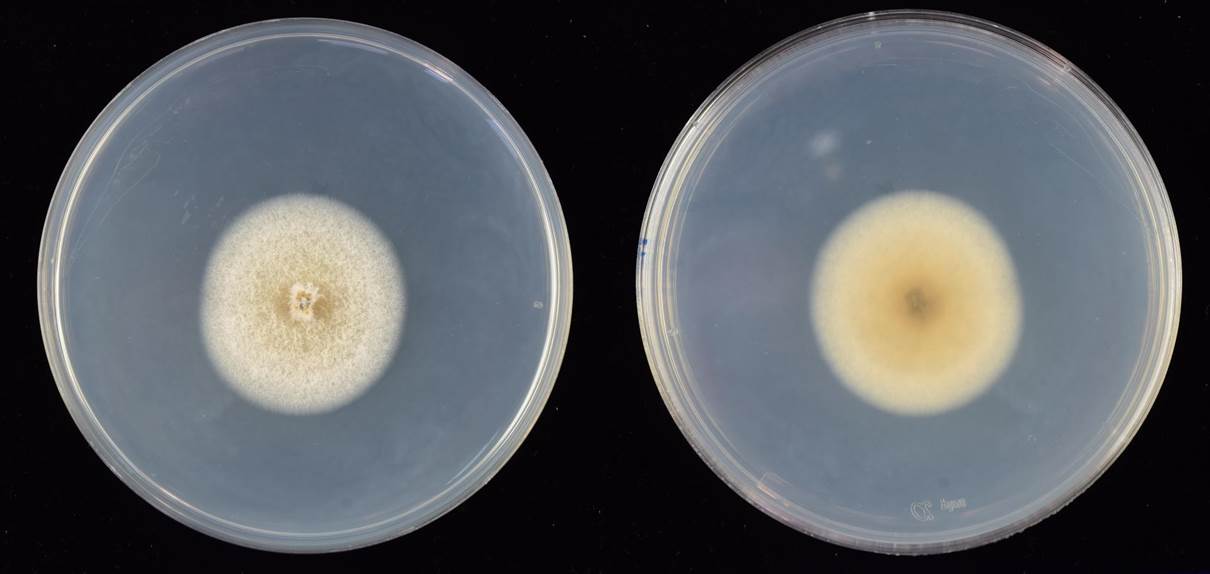| Authors | Cavara 1892 |
|---|---|
| Strain | 12055 |
| Classification | Magnaporthales, Magnaporthaceae, Magnaporthe |
| Culture collection | BCRC FU30217 |
| Detection frequency | Medium |
| Accession number | LC494384 |
| Figure |  Fig. 1 5-day-old colony on PDA Fig. 1 5-day-old colony on PDA  Fig. 2 Pyricularia oryzae. a. Sporulation on leaf lesion. b. Sporulation on WA. c. Conidia. d–f. Conidiophores and conidia (Bars= 5 μm, unless otherwise specified) Fig. 2 Pyricularia oryzae. a. Sporulation on leaf lesion. b. Sporulation on WA. c. Conidia. d–f. Conidiophores and conidia (Bars= 5 μm, unless otherwise specified)  Fig. 3 Symptoms of rice blast. Fig. 3 Symptoms of rice blast. |
| Colonies | Colonies on PDA attaining 34-, 38-, 0-mm at 24 °C, 28 °C and 37°C after 5 days, white to pale brown, margins entire, velvety, azonated, reverse brown, paler towards the margin. |
| Conidiophores | Conidiophores macronematous, mostly simple, 1–4-septate, pale brown, paler toward the apex, up to 250 µm long. |
| Conidiogenous cells | Conidiogenous cells integrate, terminal or intercalary, sympodial, geniculate and denticulate near the conidiogenous loci. |
| Conidia | Conidia pyriform to obclavate, with short, protruding hilum, slightly pigmented, 2-septate, often constricted at the second septum, 23–30 × 7.5–9.5 µm. |
| Note | In addition to rice, this species also cause blast disease on many other grasses. This species is capable of producing a large number of conidia on the tissue surface of necrotic symptom, but it rarely sporulates once cultured under laboratory conditions. For the method of inducing sporulation, methods provided by National Institute of Agrobiological Sciences (NIAS) or International Rice Research Institute (IRRI) (Hayashi et al., 2009) can be referred. Firstly, the strain is cultured on a suitable medium (e.g. OA or prune agar). After about two weeks incubation, the lid of the petri dish is removed, followed by using a sterilized toothbrush to gently brush the aerial hyphae on the surface, and then the petri dish is displaced in a large plastic box, which is covered with plastic wrap and poked several holes to keep ventilation. After another 3 to 4 days, a large amount of conidia can be induced on the surface of the medium. |
| Pathogenicity | This species is an important rice seed-borne pathogen, and causing rice blast at all stages of rice growth. |
| Specimens examined | Taiwan, Hualien County, rice grains (cultivar Taiken 16), Jul 2018, Jie-Hao Ou, 18043 Taiwan, Tainan City, rice grains (cultivar Tainan 11), Dec 2012, Jie-Hao Ou, 12055 Taiwan, Taitung County, rice grains (cultivar Taitung 30), Jan 2014, Jie-Hao Ou, 14008 |
| ITS | GAAAAACTCCAACCCCTGTGAACATAACCTCTGTCGTTGCTTCGGCGGGCACGCCCGCCGGAGGTTCAAAACTCTTATTTTTTCCAGTATCTCTGAGCCTGAAAGACAAATAATCAAAACTTTCAACAACGGATCTCTTGGTTCTGGCATCGATGAAGAACGCAGCGAAATGCGATAAGTAATGTGAATTGCAGAATTCAGTGAATCATCGAATCTTTGAACGCACATTGCGCCCGCCGGTATTCCGGCGGGCATGCCTGTTCGAGCGTCATTTCAACCCTCAAGCCTCGGCTTGGTGTTGGGGCGCCCGGGCCCTCCGCGGCCCGGGGCCCCCAAGTTCATCGGCGGGCTCGGCGGTACACTGAGCGCAGTAAAACGCGGTAAAACGCGAACCTCGTTCGGATCGTCCCGGCGTGCTCCAGCCGCTAAACCCCCAATTTTTTAAAGGTTGACCTCGGATCAGGTAGGAATACCCGCTGAACTTAA |